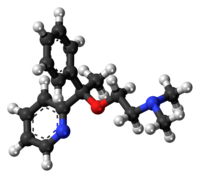
Back دوكسيلامين Arabic دکسیلامین AZB Doxilamina Catalan Doxylamin Czech Docsylamin Welsh Doxylamin German Doxilamina Spanish دوکسیلامین Persian Doxylamine French דוקסילאמין HE
 | |
 | |
| Clinical data | |
|---|---|
| Trade names | Unisom, Vicks Formula 44 (in combination with Dextromethorphan), others |
| AHFS/Drugs.com | Monograph |
| MedlinePlus | a682537 |
| Pregnancy category |
|
| Routes of administration | By mouth |
| ATC code | |
| Legal status | |
| Legal status | |
| Pharmacokinetic data | |
| Bioavailability | Oral: 24.7%[1] Intranasal: 70.8%[1] |
| Metabolism | Hepatic (CYP2D6, CYP1A2, CYP2C9)[2] |
| Elimination half-life | 10–12 hours (range 7–15 hours)[2][3][4] |
| Excretion | Urine (60%), feces (40%)[5] |
| Identifiers | |
| |
| CAS Number | |
| PubChem CID | |
| IUPHAR/BPS | |
| DrugBank | |
| ChemSpider | |
| UNII | |
| KEGG | |
| ChEBI | |
| ChEMBL | |
| CompTox Dashboard (EPA) | |
| ECHA InfoCard | 100.006.742 |
| Chemical and physical data | |
| Formula | C17H22N2O |
| Molar mass | 270.376 g·mol−1 |
| 3D model (JSmol) | |
| |
| |
| (verify) | |
Doxylamine, sold under the brand name Unisom among others, is an antihistamine medication which is used in the treatment of insomnia and allergies. It is also used to treat morning sickness in pregnant women in combination with pyridoxine (vitamin B6). Doxylamine is available over-the-counter, and is used in nighttime cold medicines, such as NyQuil, as well as in pain medications containing acetaminophen and codeine, to help with sleep. The medication is taken by mouth.
Side effects of doxylamine include dizziness, drowsiness, grogginess, and dry mouth, among others.[6][4] Doxylamine is an antihistamine—specifically an inverse agonist of the histamine H1 receptor—and to a lesser extent an anticholinergic—specifically an antagonist of the muscarinic acetylcholine receptors M1 through M5. It is a first-generation antihistamine and crosses the blood–brain barrier into the brain, thereby producing centrally mediated sedative and hypnotic effects.
Doxylamine was first described in 1948 or 1949.[7] Several of the first-generation antihistamines, including doxylamine, are the most widely used sleep medications in the world.[8] Doxylamine is also a potent anticholinergic, which means it also works as a deliriant at much higher than recommended doses as a result.[9] Its sedative and deliriant effects have led to some cases of recreational use.
- ^ a b Cite error: The named reference
pmid12214324was invoked but never defined (see the help page). - ^ a b Cite error: The named reference
KrygerRoth2010was invoked but never defined (see the help page). - ^ Cite error: The named reference
pmid29671128was invoked but never defined (see the help page). - ^ a b Cite error: The named reference
pmid27057416was invoked but never defined (see the help page). - ^ "New Zealand Datasheet: Doxylamine Succinate" (PDF). Medsafe, New Zealand Medicines and Medical Devices Safety Authority. 16 July 2008. Archived from the original on 22 March 2016.
- ^ Neubauer DN (August 2007). "The evolution and development of insomnia pharmacotherapies". Journal of Clinical Sleep Medicine. 3 (5 Suppl): S11–S15. doi:10.5664/jcsm.26930. PMC 1978321. PMID 17824496.
- ^ Fischer J, Ganellin CR (2006). Analogue-based Drug Discovery. John Wiley & Sons. p. 546. ISBN 9783527607495.
- ^ Cite error: The named reference
SimonsSimons2011was invoked but never defined (see the help page). - ^ "Doxylamine - PsychonautWiki".
© MMXXIII Rich X Search. We shall prevail. All rights reserved. Rich X Search